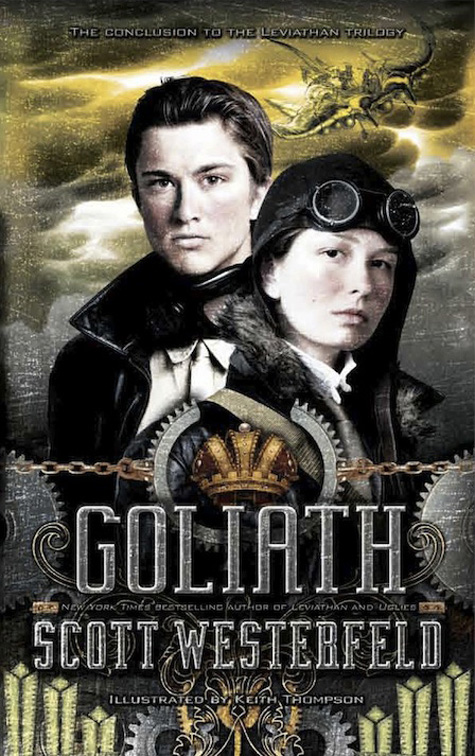In Goliath, Scott Westerfeld’s action-packed conclusion to the Leviathan trilogy, war is thundering across the globe and everyone is determined to stop it. Alek, the drifting prince—and secret heir to the Austrian-Hungarian empire—thinks that his position is the trump card that can end the fighting. But he’s not the only one with a plan. Westerfeld takes us on the final leg of Alek and Deryn’s international escapades to meet up with steampunk’s most famous (and possibly mad) scientist, Nikola Tesla. And you see, Tesla has his own special device, a contraption that could change the face of global politics for years to come or just simply destroy the world
It all starts with the whale-cum-airship making a detour to Siberia and a dangerous encounter with some of Darwinist Russia’s infamous fighting bears. The Leviathan is there to rescue the Serbian inventor, who is investigating a peculiar explosion crater. Immediately, unlike the eccentric and intriguing portrayals of Tesla in other works, Westerfeld’s Tesla is a straight-up bum-rag, mostly dedicated to scientific discovery and cold toward his fellow human beings. For example, he doesn’t seem to care about the lives and safety of his fellow researchers out in the tundra (or maybe he just had tons of faith in that fantastic lightning gun he carries with him).
Either way, Tesla is furious about the war and the Clanker invasion of his homeland of Serbia. In a response worthy of Ozymandias’s admiration, he built Goliath, a giant weapon powerful enough to blow up whole cities thousands of miles away. Or so he claims. Still, the threat of Tesla’s personal brinkmanship policy is enough to get the attention and support of the Darwinists.
Dr. Barlow, the lady boffin and granddaughter of the great Charles himself, is doubtful about Tesla’s claims, and Deryn is put on a mission to spy on the inventor. As the Leviathan takes Tesla back to his laboratory in Long Island, Alek is faced with a moral dilemma: should he support Tesla’s destructive weapon as an advocate for peace, or should he kill the man who could threaten thousands of Clanker lives? The alt hist parallel Westerfeld proposes between Goliath and the atomic bomb of our history is interesting. Instead of steampunk technology making a better future, would it only exasperate its potential violence?
Of course, this isn’t the only conflict in the book. Deryn, struggling about whether to tell Alek the truth about her gender, is discovered by Alek with the clever help of a certain loris. The romantic tension between them escalates along with the battles sequences in Goliath as they deal with the results of this discovery and are determined to hide the truth from everyone else.
Westerfeld also gets kudos for taking the time to let us readers sample other parts of the world. The Leviathan witnesses the ferocious Japanese kappa battling Russian naval ships and we see how this alternate post-Meiji Japan incorporates both Darwinist and Clanker technology. The United States also turns out to be a hybrid-technology nation, with split technologies between the North and the South. And others take advantage of whatever tech is offered their way; there is a very interesting episode when Alek—whose granduncle was Maximilian I—meets Pancho Villa in Mexico. Indeed, illustrator Kevin Thompson’s work shines the most when representing the range of cultures and technologies present in this world, and his own interpretations of some of history’s most colorful characters.
The book’s final third races to a fantastic and satisfying conclusion, and Alek and Deryn are forced to make some very hard choices about their lives. While some elements in the book felt underused (I would have loved to see Bovril push his perspicacious to another level, for instance), overall, I’m very pleased with the ending to this steampunk trilogy. Though Westerfeld has said there won’t be a fourth novel, it would be interesting to explore the scientific and political possibilities that his world holds. At least we can look forward to the upcoming Leviathan art book (first mentioned here) to help fuel our imaginations.
Ay-leen the Peacemaker is the editor for Beyond Victoriana, a blog about multicultural steampunk, along with running Tor.com Steampunk on Facebook and Twitter. If she owned a perspicacious loris, she’d probably name it Nutella, or Fred.










